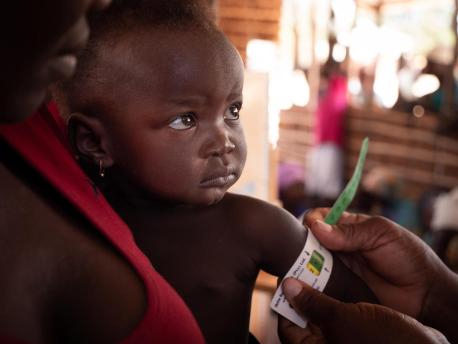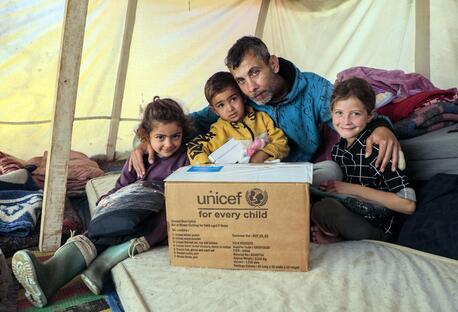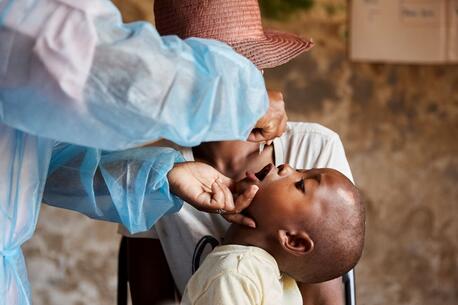
The Battle to End Undernutrition, Obesity and Hidden Hunger
One-third of the world's children under age 5 are malnourished. Here's how UNICEF is taking on a broken food system to help children thrive.
Poverty, urbanization, climate change and poor eating choices are leaving an alarmingly high number of children malnourished, according to the 2019 edition of UNICEF's annual State of the World's Children report, Children, Food and Nutrition: Growing well in a changing world.
Globally, at least 1 in 3 children under age 5 — 200 million — is undernourished or overweight, and 1 in 2 suffers from hidden hunger due to a lack of essential vitamins and minerals. The greatest burden of all forms of malnutrition falls on children and young people from the poorest and most marginalized communities, perpetuating poverty across generations.
Without healthy, nutritious food, children cannot grow up to reach their full potential
"Despite all the technological, cultural and social advances of the past few decades, we have lost sight of this most basic fact: If children eat poorly, they live poorly," said UNICEF Executive Director Henrietta Fore.
"Millions of children subsist on an unhealthy diet because they simply do not have a better choice. The way we understand and respond to malnutrition needs to change: It is not just about getting children enough to eat; it is above all about getting them the right food to eat. That is our common challenge today."
The way we understand and respond to malnutrition needs to change: It is not just about getting children enough to eat; it is above all about getting them the right food to eat.
Almost 2 out of 3 children between 6 months and 2 years are not fed food that supports their rapidly developing bodies and brains. They may survive, but they will not thrive.
Overwhelmingly, mothers said the main barrier to feeding their babies well was financial. "I cannot even afford to give my baby unhealthy foods because we do not have the money," said a 20-year-old mother in Zimbabwe.
Though breastfeeding can save lives, only 42 percent of children under 6 months are exclusively breastfed and an increasing number of children are fed infant formula, which is more expensive and less nutritious than breast milk.

In Almaty, Kazakhstan, 10-year-old Yerzhan gets ready to dig into his usual fast-food lunch: two burgers with fries and a milkshake. "I would like to stop eating burgers because they are high in calories," he said. "If I eat them every day, in the future I will become fat. This kind of lifestyle causes diseases like liver cancer, I think." © UNICEF/UNI209801/Karimova
As children grow older, they are bombarded by inappropriate marketing and advertising of unhealthy food, and inundated with ultra-processed food, fast food and highly sweetened drinks. "On a scale from 1 to 10, I would rate my eating at around 5," said 10-year-old Yerzhan in Almaty, Kazakhstan. "If I cut down on burgers, soda and milkshakes, I would give myself a higher rating."
As a result, overweight and obesity levels are increasing worldwide. From 2000 to 2016, the proportion of overweight children between the ages of 5 and 19 doubled from 1 in 10 to almost 1 in 5. Ten times more girls and 12 times more boys in this age group suffer from obesity today than in 1975.
From 2000 to 2016, the proportion of overweight children between the ages of 5 and 19 doubled from 1 in 10 to almost 1 in 5
Meanwhile, the number of severe food crises caused by climate-related disasters continues to rise. Floods, storms, drought and extreme heat around the world have collectively doubled in number since 1990, with devastating results. Drought, for example, is responsible for 80 percent of damage and losses in agriculture, dramatically altering what food is available to children and families, as well as the quality and price of that food.

In Cuba, UNICEF programs encourage good nutrition, healthy lifestyles, and physical activity among school-age children. © UNICEF/UNI206765/Fesser
Nutrition has long been at the core of UNICEF's work. In 2018, UNICEF:
- helped provide lifesaving therapeutic feeding for 4.1 million children with severe acute malnutrition
- improved the quality of diets for more than 15.6 millin children through home-based fortification
- supported programs to prevent anemia and other forms of nutrition for 58 million adolescent girls and boys
- ensured that more than 300 million children received services for the prevention of stunting and other forms of malnutrition
To address this growing malnutrition crisis, UNICEF is issuing an urgent appeal to governments, the private sector, donors, parents, families and businesses to help children grow healthy
To address this growing malnutrition crisis in all its forms, UNICEF is issuing an urgent appeal to governments, the private sector, donors, parents, families and businesses to help children grow healthy by:
- Empowering families, children and young people to demand nutritious food: Demand creates supply. When healthy options are affordable, convenient and desirable, parents and caregivers make better food choices for children.
- Driving food suppliers to do the right thing for children: Sustainable, healthy food must be available, affordable, safe and convenient. Governments must create a level playing field for food producers and suppliers.
- Building healthy food environments for all children: Mandatory front-of-package labeling and protection against exploitative marketing practices can help children make nutritious choices.
- Mobilizing supportive systems to scale up nutrition results for every child: Health, water and sanitation, education and social protection systems must work together to help ensure that children and families have access to healthy diets and that children receive the nutrition services they need to develop to their full potential.
- Collecting, analyzing and using good-quality data and evidence to guide action and track progress: Accurate and timely data on the diets of children, adolescents and women will help governments understand malnutrition and respond with effective policies, strategies and programs.
"We are losing ground in the fight for healthy diets," said Fore. "This is not a battle we can win on our own. We need governments, the private sector and civil society to prioritize child nutrition and work together to address the causes of unhealthy eating in all its forms."
For over 70 years, UNICEF has been putting children first, working to protect their righrts and provide the assistance and services they need to survie and thrive. Help UNICEF continue to improve nutrition for children.
Top photo: On September 27, 2019, a boy has his mid-upper arm circumference measured by a health worker checking for malnutrition at a UNICEF-supported community outreach medical center near the village of Mecufi in northern Mozambique. © UNICEF/UNI212574/Hubbard
HOW TO HELP
There are many ways to make a difference
War, famine, poverty, natural disasters — threats to the world's children keep coming. But UNICEF won't stop working to keep children healthy and safe.
UNICEF works in over 190 countries and territories — more places than any other children's organization. UNICEF has the world's largest humanitarian warehouse and, when disaster strikes, can get supplies almost anywhere within 72 hours. Constantly innovating, always advocating for a better world for children, UNICEF works to ensure that every child can grow up healthy, educated, protected and respected.
Would you like to help give all children the opportunity to reach their full potential? There are many ways to get involved.





